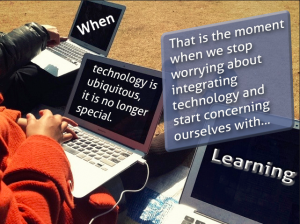Technology & Training: Technology Isn’t New Anymore by David Kelly
 At this year’s Learning Solutions Conference and Expo we will be exploring the many ways that technology has changed the world of training. The Technology & Training blog series invites members of the eLearning Guild community to share their thoughts about the growing relationships between technology and training.
At this year’s Learning Solutions Conference and Expo we will be exploring the many ways that technology has changed the world of training. The Technology & Training blog series invites members of the eLearning Guild community to share their thoughts about the growing relationships between technology and training.
We kick off the series with some thoughts from David Kelly, Program Director for The eLearning Guild.
Have you ever thought about how much technology has become a natural part of our lives? Let’s walk through how I’ve spent my Saturday, which has been a pretty average day.
For me technology is literally embedded into the start and finish of my day. If you look at my nightstand, you won’t find an alarm clock. What you’ll find is an empty space – the space that I place my smart phone at the end of the evening, right after I use the clock app to set my alarm.
My casual Saturday included the following activities:
- Checking email
- Reading the news”paper”
- Reviewing my schedule for the week
- Checking the tasks I need to accomplish
- Buying tickets for the movie we’re seeing tonight
- Deciding to put Christmas lights up tomorrow after checking the weather
- Listening to a Spotify playlist while decorating the inside of the house
- Asked Siri to answer a question my kids asked at lunch that I didn’t know the answer to
- Using Google Maps to find a holiday fair we wanted to visit
- Connected with friends on Twitter and Facebook
- Scheduled the DVR to record a show the kids wanted to watch
- Took some notes in the WordPress app related to this post
- And much more…
All of the items I’ve listed – and I could have listed a bunch more – leveraged technology. But what I think is important to realize isn’t the fact that I used technology; it’s the fact that I used technology in a completely natural way. Technology wasn’t inserted into what I was doing; it was just a part of how I live my life.
Contrast that to how we look at technology as it relates to training. Too often we look at technology in an overly-simplified way.
Enhancing What We Do
At it’s surface this idea isn’t bad. If you’re using technology to enhance the ways you are able to provide learning and performance support opportunities, that could be a really good thing.
Emphasis on the words “could be”.
Simply using technology doesn’t necessarily make things better; we need to look at why and how we are using the technology. We need to dig deeper into how we are defining enhancement.
While using technology to take what we already do and make it more efficient has value, I’d argue such a limited use of technology doesn’t enhance the work that we do. Taking a boring in-person lecture and converting it into a boring click-and-read elearning module has some value, but it’s not really enhancing the experience.
When learning professionals look at technology, we need to be asking ourselves “how can this technology help move my practice forward?”
Take mobile technology as a current example. Using responsive design to make our existing content accessible on mobile devices in an appropriate way is a step in the right direction, but it’s not enough. That’s taking what we already do and maintaining it in response to technological change. If we look at mobile technology through the lens of “How can this move my practice forward?” you see things differently.
With that question in mind, you start to notice the unique affordances of mobile devices, such as the camera, the location-based awareness, the touch interface, and other functions that we haven’t had access to previously. This brings up new questions for our existing practices, such as how these devices might be used as part of classroom training sessions, or as a way to extend the classroom experience; or what types of experiences we can create that are not limited by the point-and-click world of the desktop; or what possibilities open up when the environment knows who you are provides support once it detects your presence.
We have a history of using new technologies to implement dated methodologies. When it comes to technology and training, we need to look at technology with our eyes on the possibilities of the future, free of the shackles of what we have done in the past.
Technology isn’t New Anymore
Another aspect of the technology and training discussion that I think is important to realize is the redundancy baked into the phrase “technology and training” itself.
We use labels to generic terms to add clarity, but we tend to forget that labels often have lifecycles. I’ve often said that the phrase “online learning” has outlived it’s usefulness in a world where “online” is the default state. Years ago, in the dial-up era, “going online” had meaning. You were changing from the default state of being offline, so a phrase like “online learning” had meaning, as it was different than the offline CBT modules we were used to.
I’m feeling the same way about technology-based training. In a world where I am walking around with an always-online computer in my pocket, “technology” in itself isn’t an add-on or enhancement anymore. It’s another change to the default state, not of training, but of life.
But we still approach technology as if we’re doing something different. We treat it as something special when we add it to an aspect of classroom training. The scope in which we create elearning is a fairly defined box when compared to the ways we utilize technology in our daily lives.
And it’s in that last statement that I think we need to frame the future of the technology and training discussion. If we want learners to embrace technology-based training, then technology-based training should look a lot more like how we live our technology-based lives.
And we’re starting to see a shift to that point of view. It excites me to walk around events like LS DemoFest and see examples of individuals and organizations that are really embracing technology in innovative ways. The examples fortify my belief that we are working in the most exciting time in the history of our field, one that is being fueled by technology. It’s that “how can this technology move my practice forward?” viewpoint that will take training and development into the future.
If we embrace the possibilities.
Interested in sharing your thoughts about the relationships between technology & training? Please reach out to David Kelly for details.



Leave a Reply